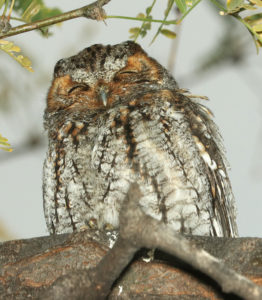Species Spotlight: Flammulated Owl
Learn more about the cup-sized flammulated owl that lives in the western US
Identification:

With a mix of gray, brown, rust, and white plumage, flams are camouflaged well against tree trunks. (Photo by Alan Schmierer)
Flammulated owls (Psiloscops flammeolus), affectionately known as flammies or flams, are fairly small, standing at about 6 inches and weighing roughly 2 ounces. Despite their small size, their wings are long, so they can achieve high speeds. With a mix of gray, brown, rust, and white plumage, flams are camouflaged well against tree trunks. These pint-sized critters have big eyes and small ear tufts that remain flat against their heads, two distinctions that are often used to differentiate them from other owls. Flammulated owls produce a variety of calls, including deep and husky hoots since they are able to slow their vocal vibrations. It is common to hear a flam before seeing one.
Life:
Because flammulated owls are nocturnal and extremely well camouflaged, they are tough to spot and even harder to study. They even migrate during the night, and there are several theories as to when their migration begins and why some populations fly south. These owls reside mostly in coniferous forests of the western United States and Mexico, and they prefer it where the trees are not dense but grow in thick enough pockets for them to safely hunt. Their diet mostly consists of beetles, moths, grasshoppers, crickets, and similar insects.
Status:
Flammulated owls are not globally threatened, but their nocturnal lifestyle makes it hard to monitor their populations. Since they like a very specific habitat, they are more vulnerable to small changes in their ecosystem. Pesticides and insecticides, wildfires, and climate change all threaten the flammulated owl. Because of its small size, a flam can lay only about two or three eggs at a time. This results in a much slower reproductive rate, but they have a long lifespan. Scientists and researchers continue to study flammulated owls in order to learn more about their habitat preferences and behavior.